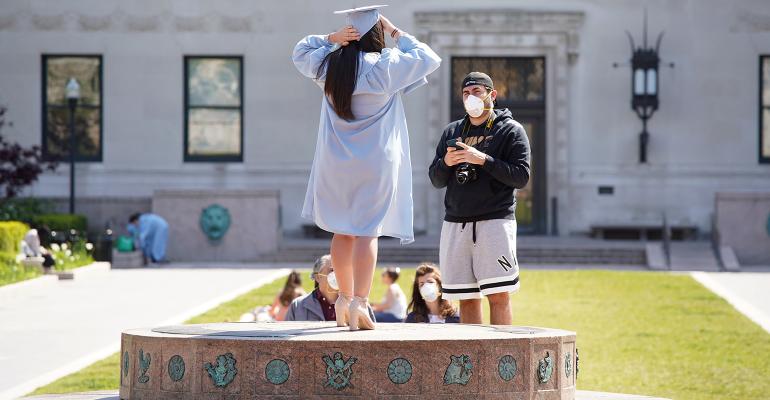Millions of borrowers are experiencing difficulty making payments on their college loans, thanks to the effects of the pandemic.
And while older clients are less likely to encounter this problem, their children may be struggling with this burden.
What’s more, some of your clients may have co-signed on their children’s private student loans. Co-signers will be on the hook for payments if their children stop paying.
The federal CARES Act, which was signed into law in March 2020, has provided some temporary relief for borrowers, but that assistance will be ending on Sept. 30.
The CARES Act provided temporary student loan relief by:
- Pausing required student loan payments.
- Suspending interest due on those payments.
- Temporarily stopping collections on defaulted federal student loans.
Many college loan borrowers, however, are going to need help after the CARES Act relief ends. In this column, you’ll learn of other avenues too.
Relief for Private College Loans
While the CARES Act helped federal college borrowers, it did not extend to borrowers with private college loans. Borrowers having difficulty repaying those loans have to contact their lenders for relief.
A survey released in July by Student Loan Hero shows that most borrowers, who thought to contact their private lenders, are getting help. Interestingly, more men (65%) than women (42%) have asked private lenders for relief.
Thirty-eight percent of respondents, however, said they didn’t know they could ask for help, and another 8% thought that asking wouldn’t be successful.
In the survey, only 10% of borrowers who asked for some type of help were rejected.
In the survey, private lenders offered the following types of help to borrowers:
- Payment deadline extensions (66%)
- Waived late fees (48%)
- Reduced minimum payments (36%)
What I found interesting was that not all of those seeking help from private lenders had been harmed. Nearly 45% of borrowers who asked for temporary relief hadn’t had their income impacted by the pandemic.
The survey creators suggested that these borrowers might have thought the relief could give them time to build up their emergency fund in case they ultimately get laid off or encounter financial distress from the pandemic-induced recession.
College Loan Repayments
Whether or not we are still in the midst of a pandemic, there are other ways to minimize or in some cases even eliminate the college debt burden.
For one, borrowers who can’t manage their current federal loan repayments can choose a different repayment method.
The most common repayment method that borrowers choose when they have graduated from college is a 10-year term. Borrowers who want to repay the loan as soon as possible select this standard repayment and, if possible, pay more than the required monthly amount.
The federal government, however, offers four other repayment options that are classified as income-driven. These income-driven repayment plans set a monthly student loan payment at an amount that is intended to be affordable based on the borrower’s income and family size. Essentially, income-based plans are intended to have borrowers pay what they can afford rather than what they owe.
Here are the four plans:
- Revised Pay As You Earn Repayment Plan (REPAYE)
- Pay As You Earn Repayment Plan (PAYE)
- Income-Based Repayment Plan (IBR)
- Income-Contingent Repayment (ICR)
The only one of the four extended repayment method that parents who borrow through the Parent PLUS Loan are eligible for is the income-contingent repayment method.
Borrowers should use the federal repayment estimator to see what plans they might be eligible for. The estimator also calculates what a borrower’s monthly payments would be along with the total lifetime cost of different repayment options.
It can guide a borrower based on these repayment goals:
- Fastest payoff
- Lowest monthly payment
- Lowest total paid over time
- Monthly payment I chose
- Total paid by a certain date
Federal Loan Forgiveness
Beyond making federal loans more manageable, there are programs to eliminate them entirely.
It is much more difficult to wipe out federal college loan debt, but it's not impossible.
The biggest federal loan discharge program is Public Service Loan Forgiveness, which allows for remaining federal student loan debt to be forgiven after the borrower has made 120 qualifying payments.
The program is designed to encourage people to go into public service jobs, which often have lower salaries. The occupations and fields eligible for this program include:
- Public education
- Public health
- Peace Corps
- Churches
- Children’s rights organizations
- Public libraries
- Military and law enforcement
- Public interest law
Other federal loan discharge and forgiveness programs include Teacher Loan Forgiveness, Closed School Discharge, Total and Permanent Disability Discharge, Discharge in Bankruptcy, Borrower Defense to Repayment, False Certification Discharge, Unpaid Refund Discharge, and Eligibility for Parent Borrowers.
Lynn O’Shaughnessy, a nationally recognized college expert, offers an online course—Savvy College Planning—exclusively for financial advisors. Click here to get Lynn’s guide, Finding the Most Generous Colleges.





